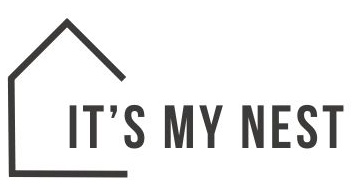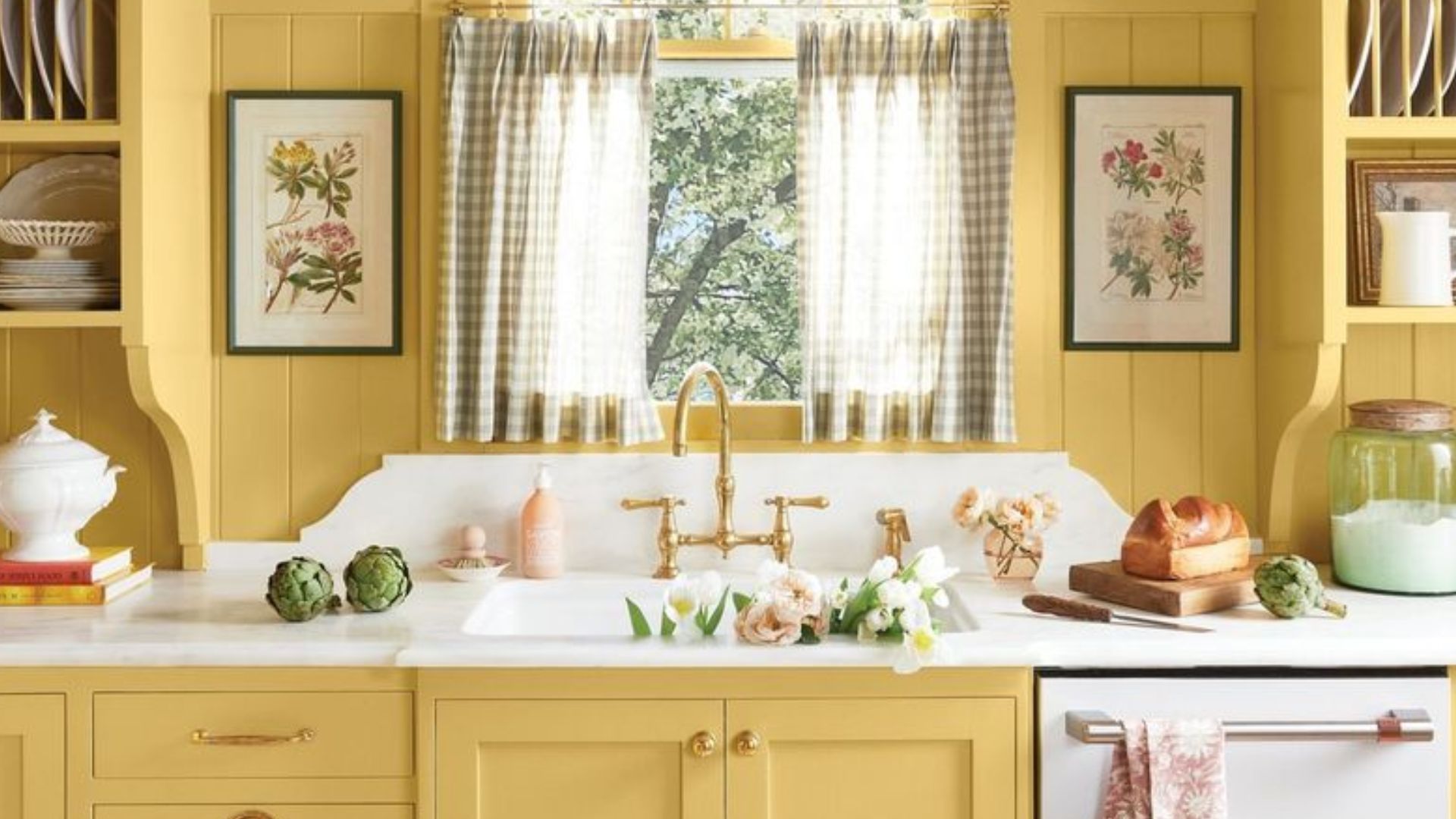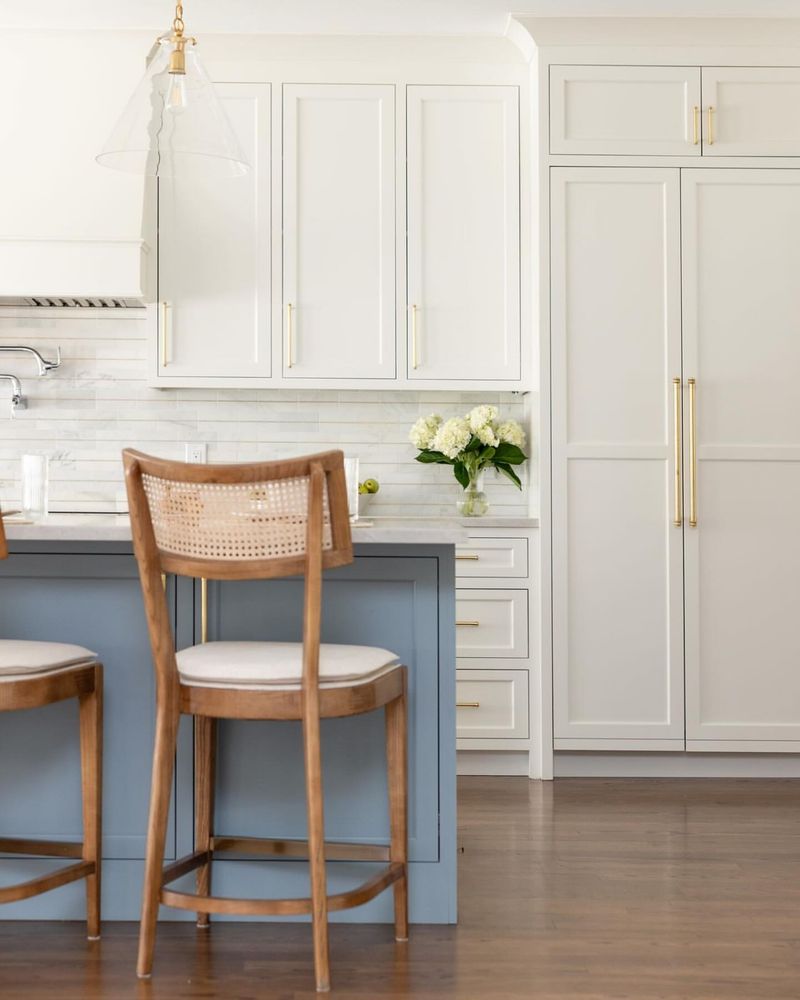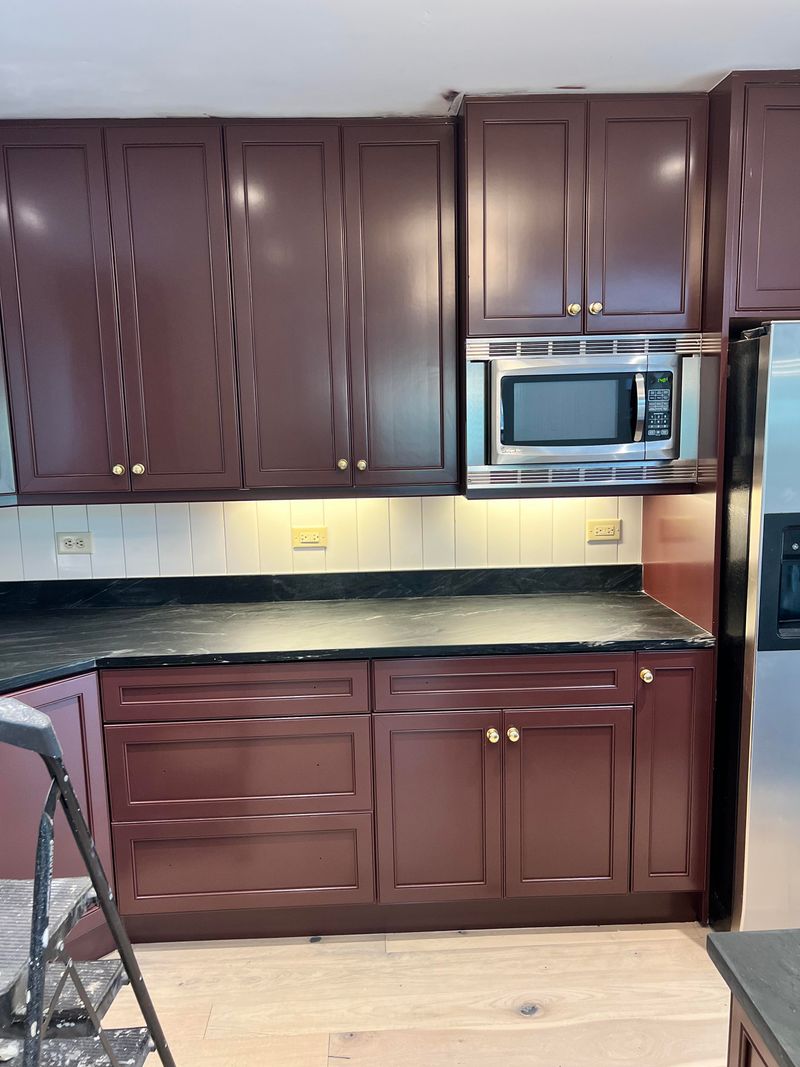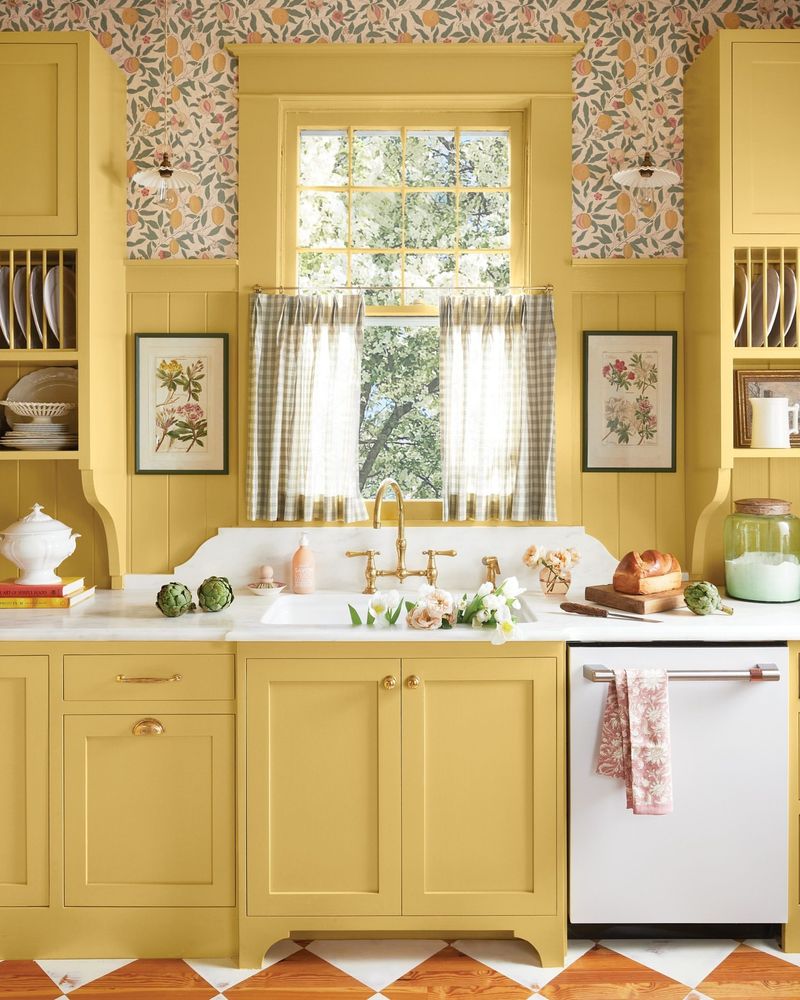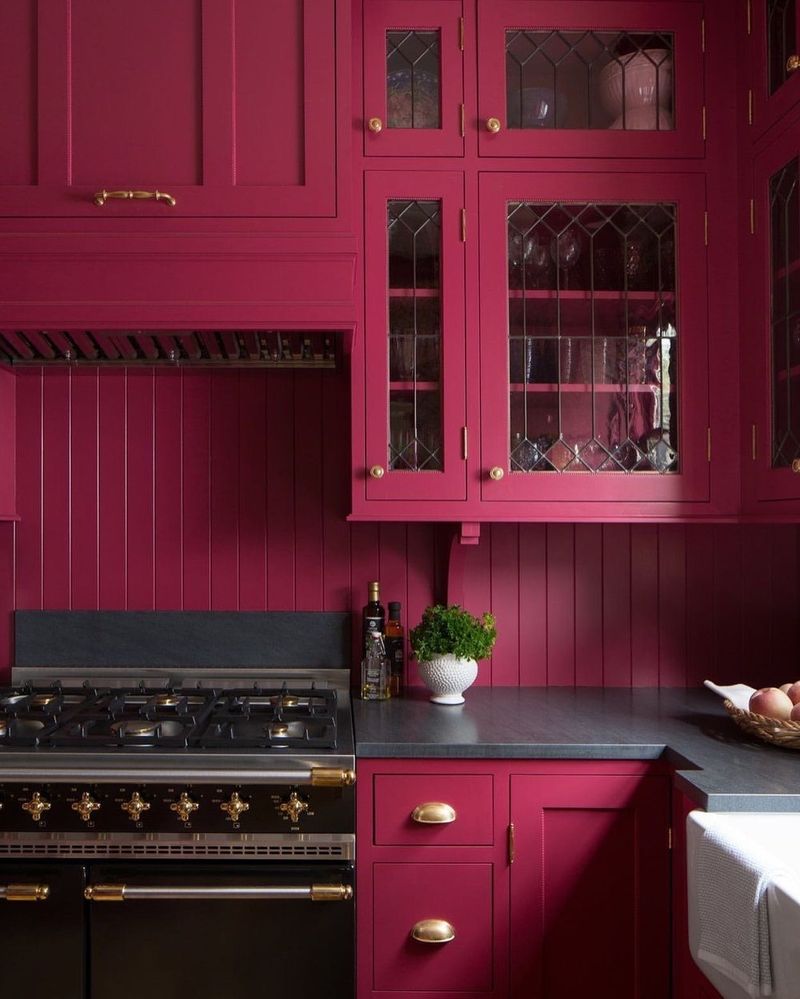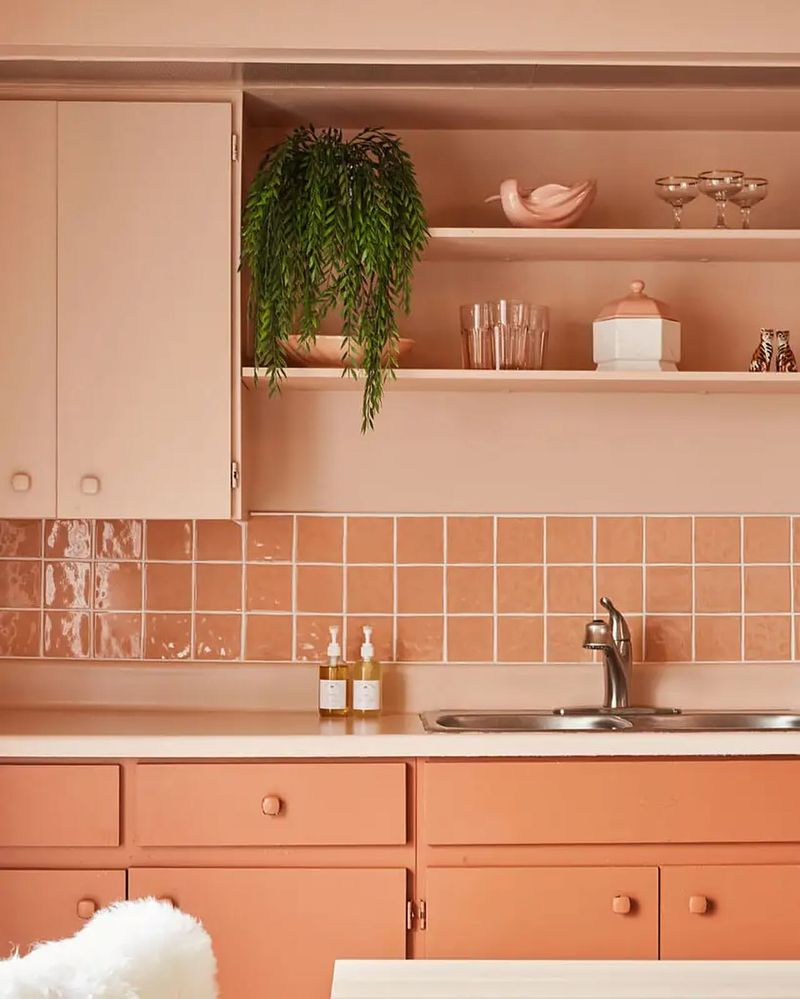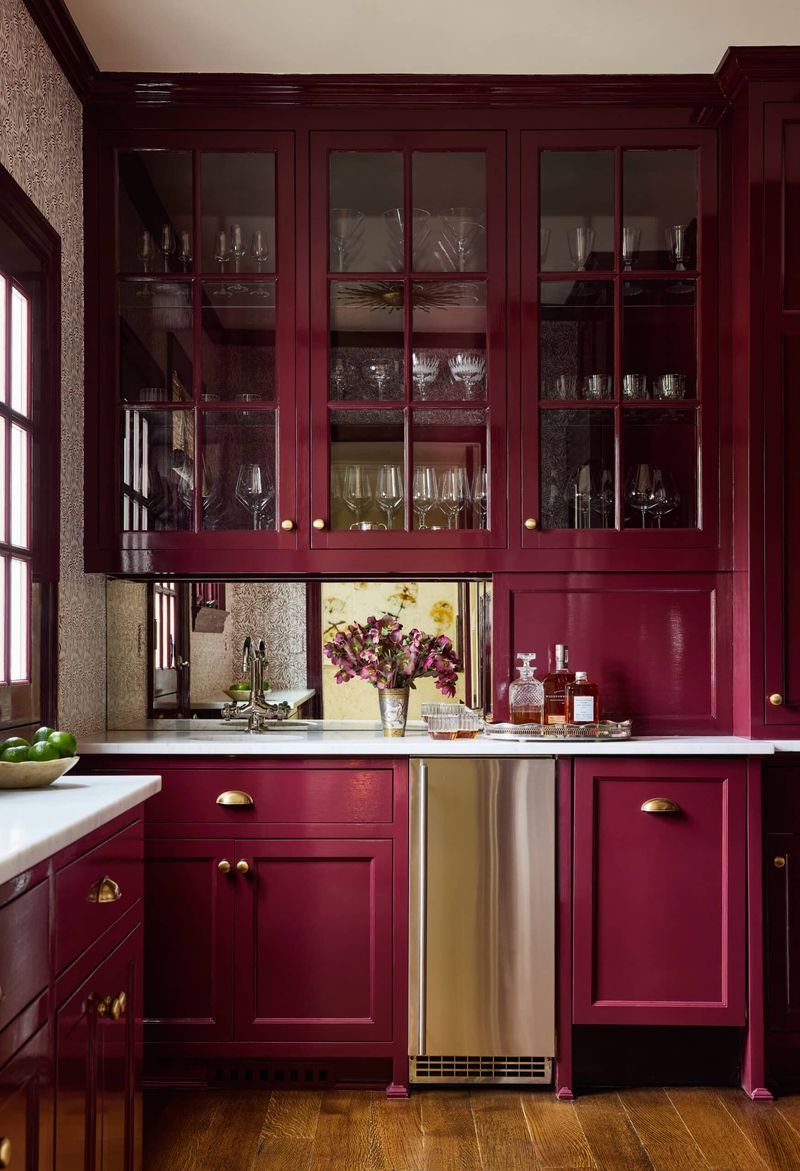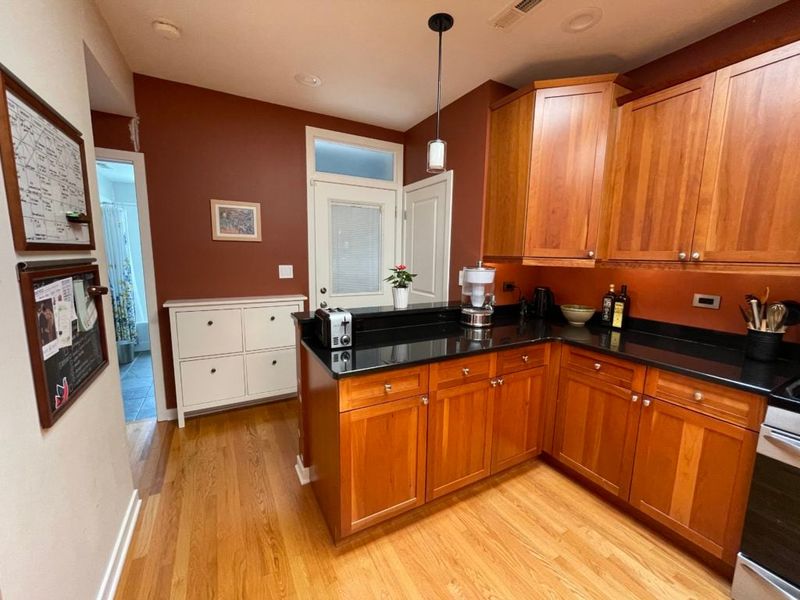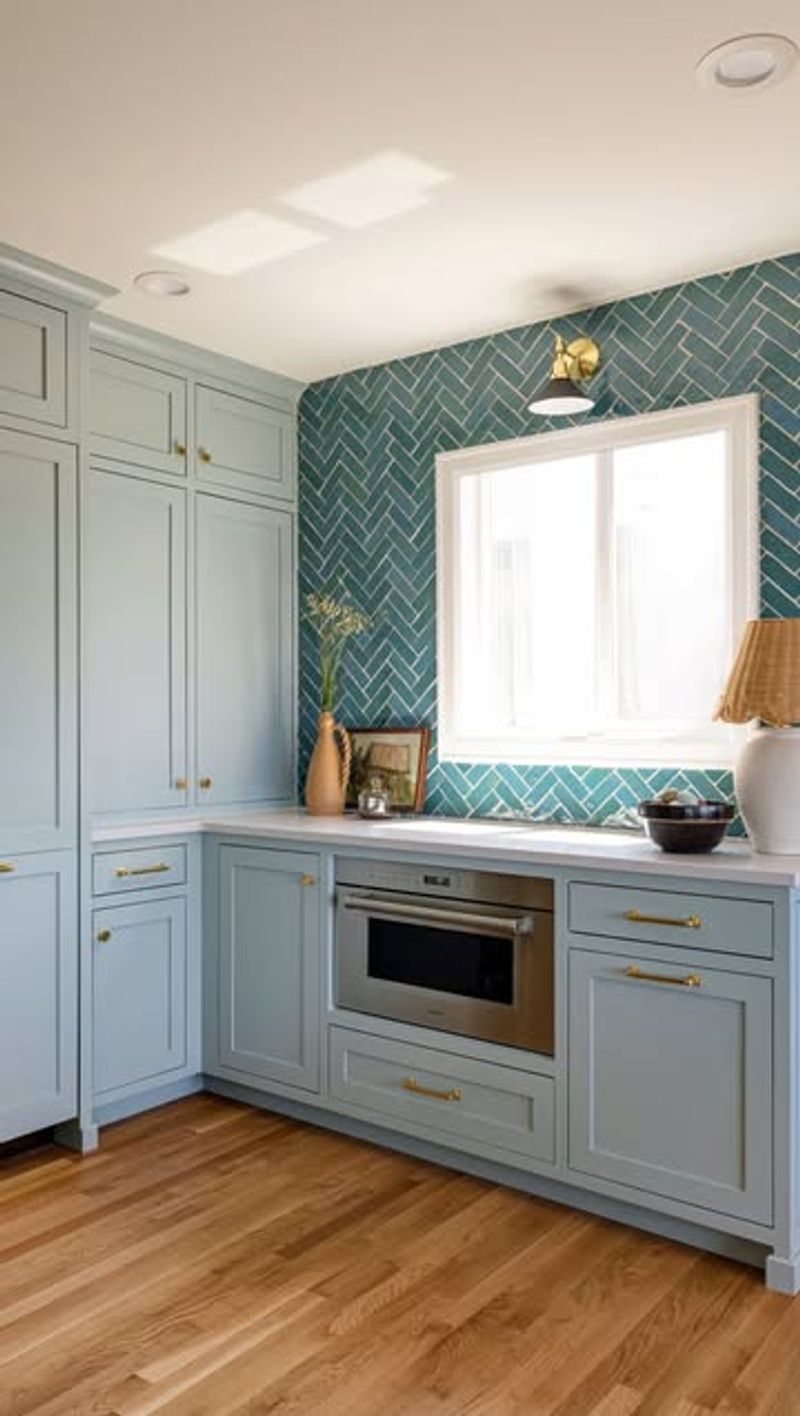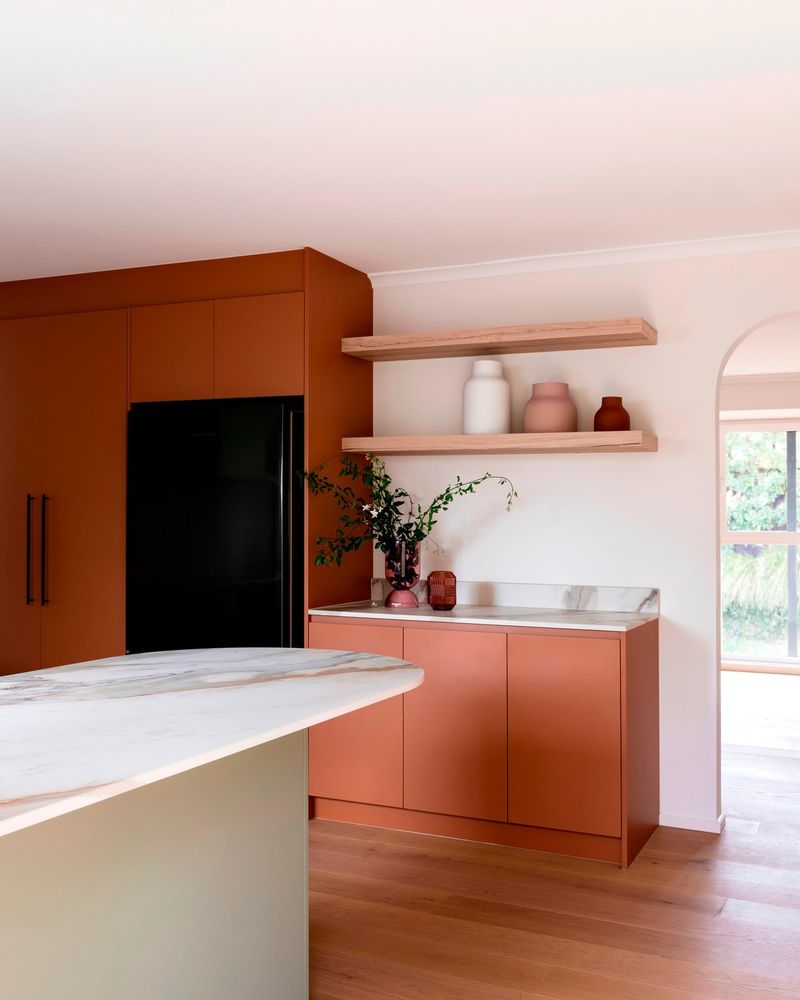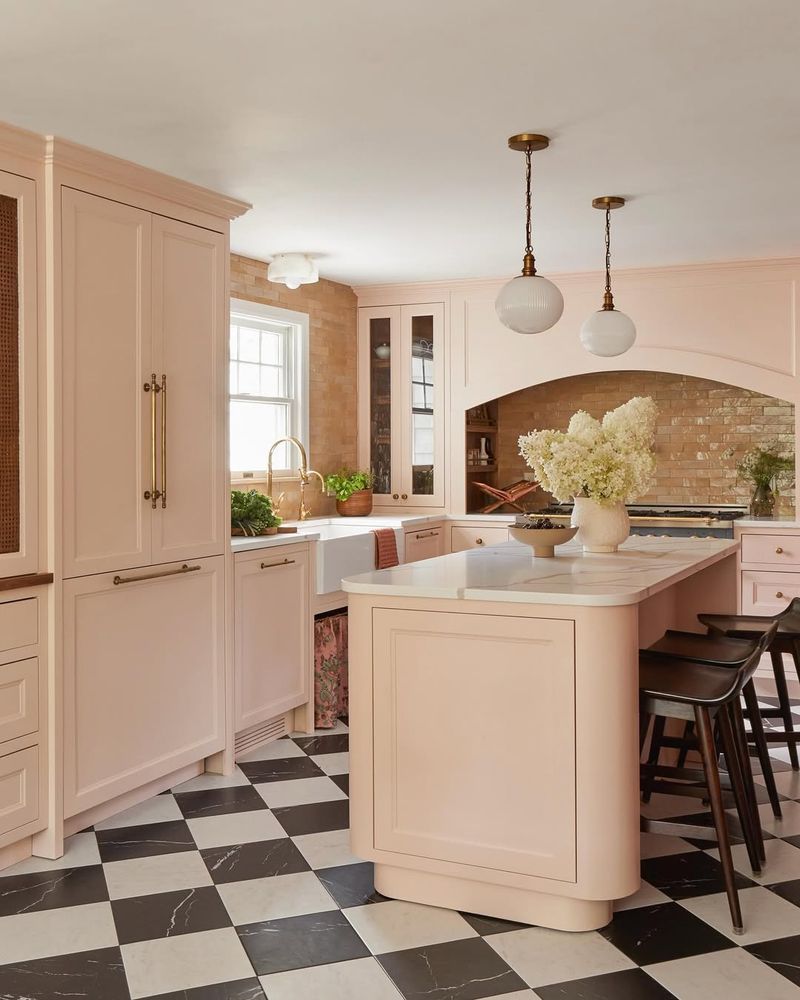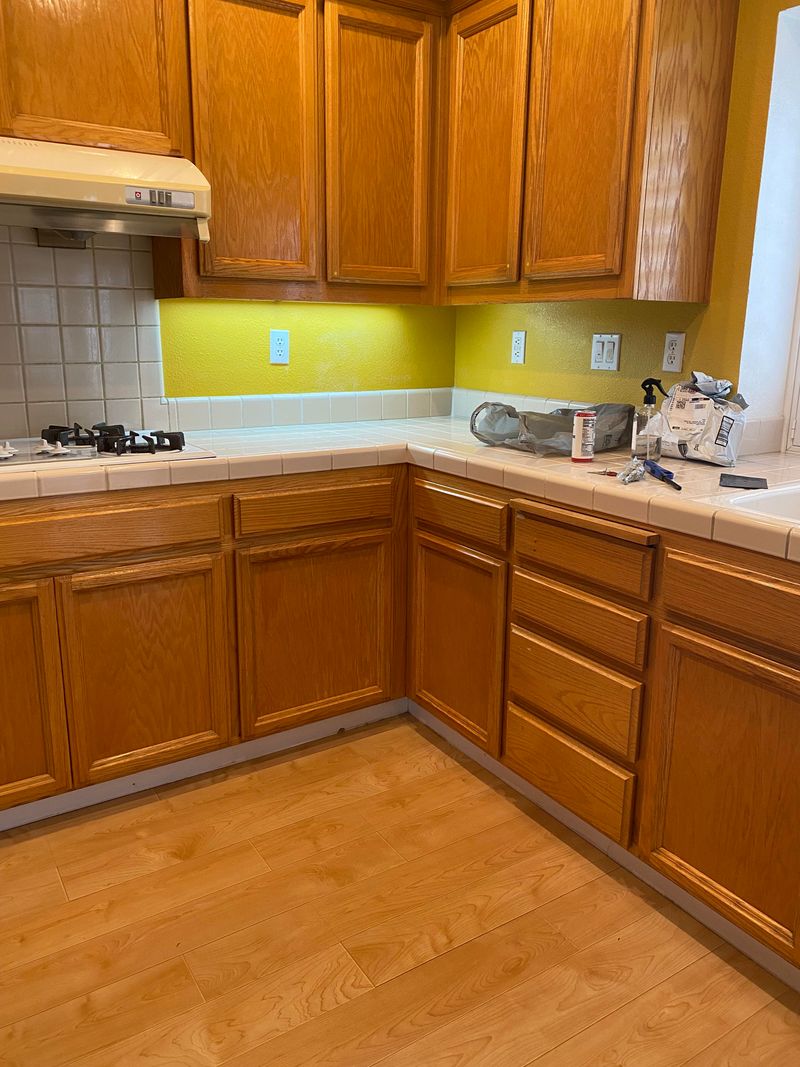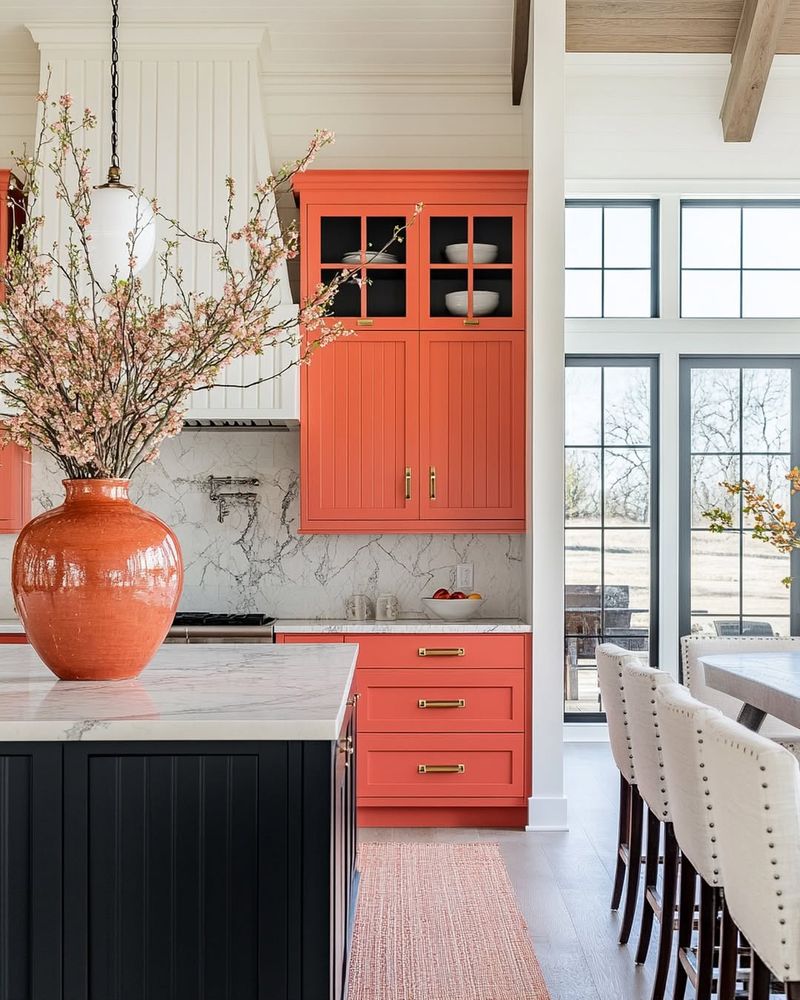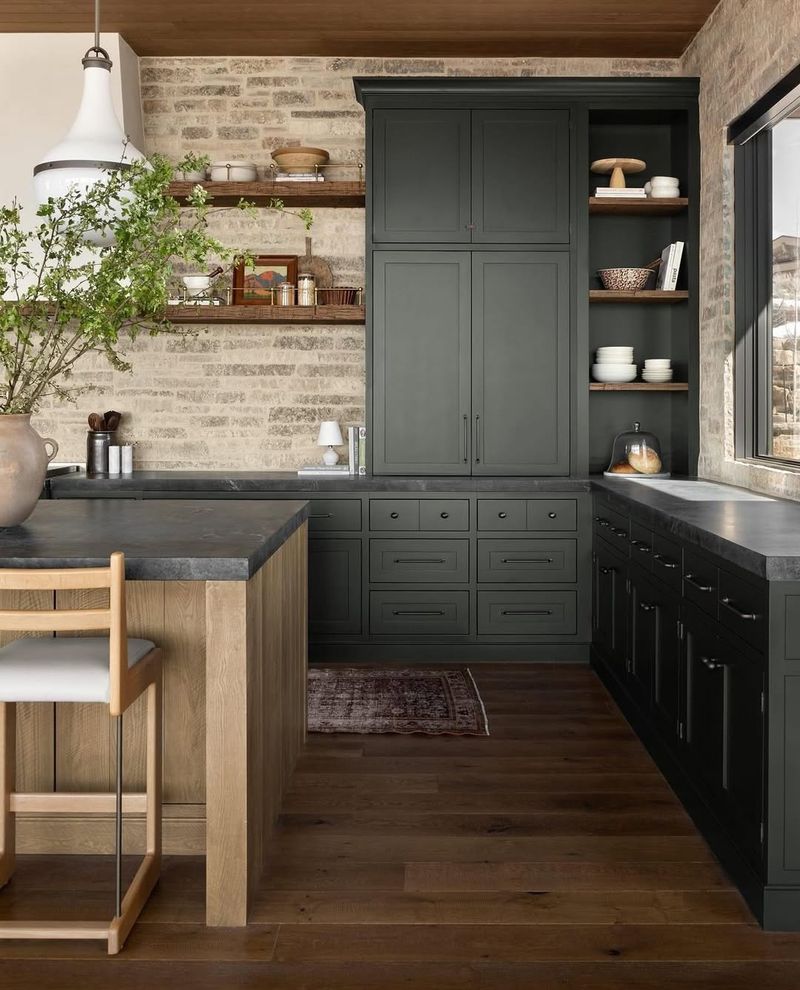The 1990s boasted a range of vibrant and distinct kitchen paint colors that many still hold dear. These hues not only defined homes of the era but also encapsulated the eclectic and adventurous spirit of the decade.
Today, we delve into 24 iconic kitchen paint colors from the 90s, each with its own unique charm and story.
1. Hunter Green
If you loved the earthy tones of the 90s, then hunter green was probably on your list. This deep, lush color brought the outdoors inside, creating a cozy and inviting atmosphere. The kitchen space would feel warm and connected to nature.
In smaller kitchens, it was paired with light wood cabinets to balance the depth of the shade. Hence, it added a sense of sophistication and warmth. Hunter green is still favored today for its timeless appeal.
2. Navajo White
Navajo White was a go-to for those who wanted a neutral yet warm tone in their kitchen. This creamy, off-white hue provided a soft backdrop that complemented a variety of kitchen decors. The color was versatile, pairing seamlessly with both traditional and modern styles.
How did it enhance kitchens? By bringing a subtle warmth that avoided the starkness of pure white, while still maintaining brightness. It remains a popular choice for those seeking understated elegance.
3. Mauve
Mauve was a darling of the 90s, offering a soft, feminine touch to kitchen spaces. It merged the calmness of blue with the warmth of red, creating a balanced hue. Mauve was often chosen for its ability to add a hint of color without overwhelming the room.
Where could you see it best? In kitchens accented with pastel accessories or floral patterns. Though it might seem dated to some, mauve continues to have its charm for a vintage look.
4. Sunflower Yellow
However bold it may have seemed, sunflower yellow brought a burst of sunshine into 90s kitchens. This cheerful color was perfect for brightening up spaces and adding energy. Kitchens painted in sunflower yellow often felt vibrant and lively. It was a favorite for those who wanted to make a statement.
The sunny hue worked well with both contemporary and rustic decor elements. Though trends have shifted, sunflower yellow remains an exciting choice for those not afraid of color.
5. Cranberry Red
Cranberry Red made a bold appearance in the 90s, offering a rich and luxurious feel to kitchens. If you wanted drama and depth, this was your color. It added an element of sophistication but required a careful balance with lighter tones to avoid overwhelming the space.
Often accented with metallics or whites, cranberry red kitchens were striking and memorable. Despite being a bold choice, this color has a timeless appeal that continues to captivate.
6. Slate Blue
Slate Blue was for those who preferred a cooler, more subdued color palette. This elegant shade offered a calm and soothing atmosphere ideal for kitchens. By combining the serenity of blue with a hint of gray, it provided versatility and sophistication.
Kitchens with slate blue walls often felt serene and stylish. It was especially popular in homes aiming for a casual yet refined look. Slate blue remains a go-to for those who appreciate understated elegance.
7. Terracotta
Terracotta was a nod to earthy tones and rustic charm, adding warmth to 90s kitchens. This muted, clay-like color brought a sense of the Mediterranean into the home. It was often complemented by natural materials such as wood and stone.
Kitchens with terracotta walls felt cozy and inviting, perfect for family gatherings. Although some see it as dated, terracotta continues to be appreciated for its organic and timeless appeal. It’s perfect for creating a warm, welcoming space.
8. Peach
Soft and inviting, peach was a popular choice for those seeking a gentle touch in their kitchen. This warm, pastel hue brought a sense of tranquility and warmth to the heart of the home.
Peach walls paired beautifully with white or cream accents, creating a harmonious and welcoming environment. Spaces adorned in peach felt light and airy, ideal for morning breakfasts. How does it stand today? Still loved for its subtle charm and ability to uplift any space.
9. Teal
Teal was a striking choice for those wanting a bold, energetic kitchen in the 90s. This vivid blue-green hue brought a refreshing pop of color to the space, making it feel lively and modern. Teal was often paired with white or wooden accents, balancing its intensity.
Kitchens featuring this color felt dynamic and creative, perfect for those who loved a bit of flair. Teal remains a popular choice for its ability to energize and inspire within the home.
10. Coral
Coral provided a vibrant, cheerful touch to 90s kitchens. This lively hue, sitting between pink and orange, was perfect for those who wanted a pop of color without being too bold. Coral walls brought warmth and vibrancy to any kitchen space.
How did it interact with other colors? It enlivened spaces when paired with neutrals or soft pastels. Coral continues to be a beloved choice for its playful yet sophisticated nature, making any kitchen feel bright and inviting.
11. Burgundy
Burgundy exuded a classic elegance, perfect for those seeking a richer, more formal kitchen ambiance in the 90s. This deep red hue added depth and sophistication, often paired with gold or brass accents for a touch of luxury.
It was favored for its ability to create a warm and inviting atmosphere. Kitchens featuring burgundy felt timeless and stately, appealing to traditional tastes. Though less common today, burgundy’s regal charm still holds appeal in traditional settings.
12. Mint Green
Mint Green offered a fresh, rejuvenating touch to 90s kitchens. This soft, pastel hue was perfect for those seeking a light and airy feel. Kitchens painted in mint green felt lively and refreshing, evoking a sense of cleanliness and simplicity.
It was often paired with white or light wood accents to enhance its brightness. Mint green continues to be a popular choice for its ability to bring a sense of calm and freshness to any space, ideal for a kitchen setting.
13. Lavender
Lavender was a trendsetting choice in the 90s, offering a soft, calming presence in kitchens. This gentle hue combined the tranquility of blue with the warmth of pink, creating a balanced and inviting atmosphere.
The feeling? Relaxing and subtly elegant, often brightened with white or cream furnishings. Lavender remains a favorite for its unique ability to calm and soothe, making it an excellent choice for creating a peaceful kitchen environment.
14. Rust
Rust brought a grounded, earthy feel to 90s kitchens, drawing inspiration from natural materials. This warm, reddish-brown hue added depth and character to a space, perfect for those looking to create a cozy, inviting atmosphere.
Rust-colored walls felt warm and connected to nature, often enhanced with wooden or metal accents. Despite being seen as a more traditional choice, rust continues to be favored for its timeless appeal and ability to evoke warmth and comfort.
15. Powder Blue
Powder Blue offered a serene, airy quality to kitchens in the 90s, making it a favorite among those who desired calmness. This soft, light blue hue provided a refreshing backdrop, ideal for both modern and traditional kitchen styles.
By pairing it with whites or light woods, kitchens felt open and tranquil. The subtle elegance of powder blue continues to be appreciated today for its gentle, peaceful nature, creating a relaxing and inviting kitchen space.
16. Ochre
Ochre, with its earthy, golden tones, brought a rich, warm quality to 90s kitchens. This color, reminiscent of autumn leaves, added depth and warmth to the heart of the home. Kitchens painted in ochre felt cozy, often highlighted with natural materials like wood and stone.
Despite its boldness, it offered a timeless appeal, perfect for those seeking a grounded, rustic feel. Ochre remains popular for its ability to create a welcoming and warm atmosphere in any kitchen.
17. Blush Pink
Blush pink brought a hint of romance and softness to 90s kitchens. This delicate hue offered a subtle yet charming touch, perfect for creating a warm, inviting space. Kitchens featuring blush pink walls felt gentle and welcoming, often paired with whites or creams for a balanced look.
Though bold colors have taken precedence today, blush pink remains cherished for its sweet, gentle nature, ideal for those who appreciate a softer aesthetic in their kitchen.
18. Mustard Yellow
Mustard Yellow was a daring choice for kitchen walls in the 90s, offering a bold, vibrant touch. This rich, golden hue brought warmth and energy, making kitchens feel lively and welcoming. Often paired with dark woods or black accents, mustard yellow provided a stunning contrast.
Though it required a careful balance, this color added a unique character to any space. Mustard yellow continues to be loved for its ability to infuse kitchens with warmth and a touch of retro flair.
19. Sage Green
Sage Green brought a sense of calm and earthiness to 90s kitchens, perfect for those seeking a natural vibe. This muted green hue was soft yet sophisticated, creating a relaxed atmosphere. Kitchens painted in sage green felt serene and balanced, often complemented by wooden or cream accents.
Today, sage green remains a popular choice for its ability to bring tranquility and a connection to nature, ideal for creating a peaceful, harmonious kitchen environment.
20. Burnt Orange
Burnt Orange offered a warm, inviting feel to kitchens, perfect for those embracing bold color choices in the 90s. This rich, earthy hue added depth and vibrancy, making kitchens feel cozy and connected to nature.
When paired with metallics or deep woods, it created a striking contrast. Burnt orange continues to be a favorite for its ability to evoke warmth and comfort, creating a lively yet grounded atmosphere in any kitchen.
21. Brick Red
Brick Red gave a strong, rustic feel to many kitchens in the 90s, ideal for those wanting a touch of traditional charm. This bold, earthy hue brought a sense of warmth and solidity to the heart of the home. Brick red walls felt inviting, often paired with natural materials like wood and stone for a cohesive look. While trends have shifted, brick red remains valued for its robust character and ability to create a welcoming kitchen space.
22. Sky Blue
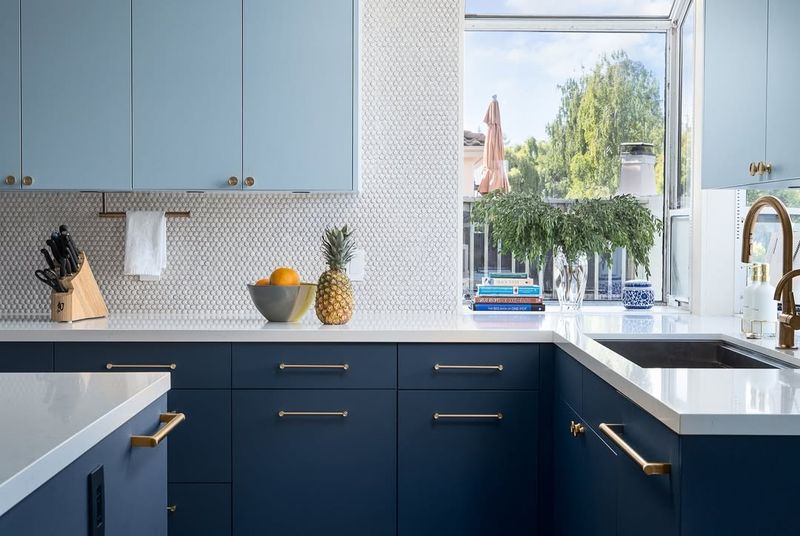
Sky Blue provided a light, airy feel to kitchens in the 90s, perfect for those who wanted a touch of brightness. This soft, cheerful hue made kitchens feel open and refreshing, ideal for capturing natural light.
Often paired with white accents, sky blue created a harmonious, inviting atmosphere. Despite the changing trends, sky blue continues to be loved for its uplifting nature and ability to make kitchens feel serene and expansive.
23. Charcoal Gray
Charcoal Gray added a modern, sophisticated touch to 90s kitchens, ideal for those seeking a sleek look. This dark, neutral hue provided a contemporary, stylish backdrop that paired well with stainless steel or bright accents. Painted in charcoal gray felt cool and refined, appealing to modern tastes. Although trends have evolved, charcoal gray remains a popular choice for its timeless appeal and ability to add a chic, elegant touch to any kitchen setting.
24. Almond
Almond was a popular choice among homeowners in the 90s who wanted a warm yet neutral backdrop for their kitchens. This soft, beige-like hue provided a subtle elegance without overpowering the room’s other elements.
The color worked beautifully with wooden cabinetry and vintage kitchen accessories, creating a harmonious blend that was both inviting and stylish. Almond allowed for versatility, making it easy to pair with various kitchen decor styles.
Homeowners appreciated its ability to brighten up spaces while maintaining a cozy feel, making it a timeless choice that continues to be cherished by those fond of 90s nostalgia.
